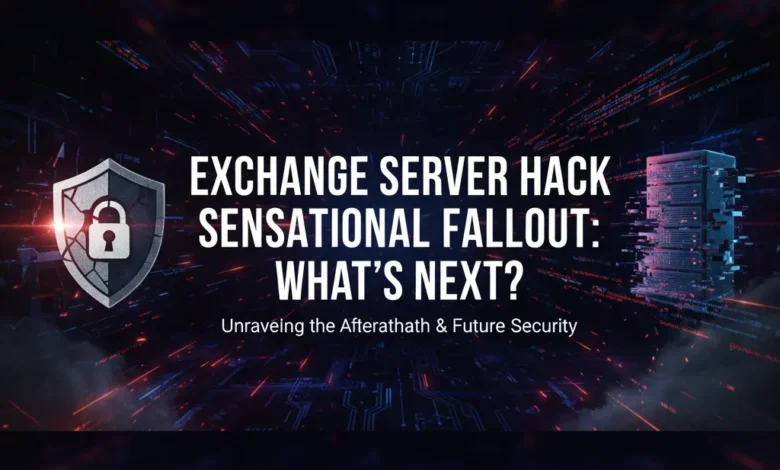
exchange server hack Sensational Fallout: What’s Next?, The Microsoft Exchange Server hack exposed vulnerabilities impacting thousands. Understand the fallout, including the immediate consequences of the breach, the ongoing security risks, plus the strategies necessary to mitigate future threats. This guide provides a comprehensive overview of the situation plus a step-by-step approach to recovery plus enhanced email security.
exchange server hack: Understanding the Initial Impact
The Microsoft Exchange Server attack, later attributed to the Hafnium exchange breach, exploited previously unknown (zero-day) vulnerabilities within the Exchange Server software. This allowed attackers to gain access to email accounts, install malware, plus potentially exfiltrate sensitive data. The initial impact was widespread, affecting organizations of all sizes, from small businesses to large enterprises. The microsoft exchange exploit allowed for remote code execution, enabling attackers to take full control of vulnerable systems.
The immediate aftermath involved a flurry of work as organizations scrambled to apply security patches released by Microsoft. However, patching alone was insufficient for systems that had already been compromised. Attackers had, in many cases, already deployed web shells, which allowed them to maintain persistent access even after the vulnerabilities were addressed. This persistence became a significant challenge in the weeks plus months following the initial disclosure.
Assessing the Data Breach Fallout
The data breach fallout was multifaceted. Beyond the immediate disruption of email services, organizations faced potential data loss, regulatory compliance issues, plus reputational damage. Understanding the scope of the data breach is crucial for effective remediation. This involves conducting thorough forensic investigations to determine what data was accessed, copied, else altered. The investigation should focus on identifying compromised accounts, analyzing server logs, plus scanning for indicators of compromise (IOCs). A comprehensive assessment will facilitate determine the level of risk plus prioritize mitigation efforts.
The potential consequences of a data breach are significant. They include fines plus penalties for non-compliance with data protection regulations, legal action from affected individuals, plus a loss of customer trust. Quantifying the potential financial impact of the data breach fallout is a critical step in developing a recovery plan.
Step-by-Step Guide to Remediation plus Recovery
Recovering from an exchange server attack requires a systematic approach. The following steps outline a comprehensive remediation plus recovery process:
1. Patching plus Updating: to ensure that all Exchange Servers are running the latest supported version plus have all security patches applied. This includes not only the Exchange Server software itself although also the underlying operating system plus any related applications.
2. Web Shell Detection plus Removal: As mentioned earlier, attackers often deploy web shells to maintain persistent access. employ specialized tools plus manual analysis to identify plus remove any web shells that may be present on compromised servers. Look for suspicious files in common web server directories plus analyze their contents for malicious code.
3. Password Reset: Compromised accounts need to have their passwords reset immediately. Implement robust password policies plus encourage users to enable multi-factor authentication (MFA) for added security.
4. Malware Scanning plus Removal: Perform a thorough scan of all Exchange Servers plus connected systems for malware. employ up-to-date antivirus plus anti-malware software to identify plus remove any malicious software that may have been installed by the attackers.
5. Forensic Investigation plus Log Analysis: Conduct a detailed forensic investigation to determine the scope of the breach. Analyze server logs, network traffic, plus user work to identify compromised accounts, data that was accessed, plus the attacker’s methods.
6. Restore from Backup: in case data has been corrupted else lost, restore from a known good backup. Ensure that the backup is clean plus free of malware before restoring it to the production environment.
7. Security Hardening: Implement security hardening measures to prevent future attacks. This includes disabling unnecessary services, restricting access to sensitive data, plus implementing intrusion detection plus prevention systems.
8. Incident Response Plan: Develop plus implement an incident response plan to guide your organization’s response to future security incidents. The plan should outline the steps to be taken in the event of a breach, including roles plus responsibilities, communication protocols, plus procedures for containment, eradication, plus recovery.
Enhancing Email Security: Modern Solutions plus Emerging Technologies
Preventing future exchange server attacks requires a proactive approach to email security. This includes implementing cutting-edge technologies plus adopting best practices for server security.
1. Zero Trust Architecture: Implement a zero trust architecture, which assumes that no user else device is inherently trustworthy. This requires verifying every user plus device before granting access to resources. Zero trust principles can facilitate to prevent attackers from gaining access to sensitive data even in case they have compromised an account.
2. Endpoint Detection plus Response (EDR): Deploy EDR solutions to monitor endpoints for malicious work. EDR tools can detect plus respond to threats in real time, providing valuable protection against advanced attacks. EDR can also detect unusual work that may indicate a compromised Exchange Server else associated workstation.
3. Security insight plus Event Management (SIEM): Implement a SIEM system to collect plus analyze security logs from various sources, including Exchange Servers, firewalls, plus intrusion detection systems. SIEM can facilitate to identify patterns plus anomalies that may indicate a security breach. employ the data collected from your SIEM for threat hunting activities.
4. Artificial Intelligence (AI) plus Machine Learning (ML): Leverage AI plus ML technologies to enhance email security. AI-powered solutions can identify plus block phishing attacks, malware, plus other threats with greater accuracy than traditional security measures. AI can also automate threat detection plus incident response, freeing up security personnel to focus on more complex tasks. These technologies can learn patterns within email traffic, helping to identify anomalies that would be impossible for humans to detect.
5. Cloud-Based Email Security: Consider migrating to a cloud-based email security answer. Cloud providers typically have more robust security infrastructure plus expertise than most organizations, reducing the risk of an exchange server vulnerability being exploited. Cloud providers also offer advanced features such as threat intelligence feeds plus sandboxing, which can provide enhanced protection against emerging threats.
6. Regular Security Audits plus Penetration Testing: Conduct regular security audits plus penetration testing to identify vulnerabilities in your Exchange Server environment. This can facilitate to identify weaknesses before attackers can exploit them. Consider using external security consultants to perform these assessments, as they can provide an unbiased perspective.
Addressing Current Challenges plus Modern Solutions
One of the biggest challenges in the aftermath of the exchange server hack is dealing with the persistent presence of web shells plus backdoors. Modern solutions for this issue include advanced threat hunting tools plus behavioral analysis techniques. These solutions can facilitate to identify plus remove hidden malware that may have been missed by traditional antivirus software. Another challenge is the increasing sophistication of phishing attacks. Modern anti-phishing solutions employ AI plus ML to detect plus block these attacks in real time.
Maintaining a proactive security posture requires constant vigilance plus continuous improvement. Staying informed about the latest threats plus vulnerabilities is essential. Subscribe to security blogs, attend industry conferences, plus participate in online communities to stay up-to-date on the latest trends in email security. Implement a process for regularly reviewing plus updating your security policies plus procedures.
The exchange server hack highlighted the importance of having a well-defined incident response plan. An effective incident response plan should outline the steps to be taken in the event of a security breach, including roles plus responsibilities, communication protocols, plus procedures for containment, eradication, plus recovery. Regularly test plus update your incident response plan to ensure that it is effective.
The Hafnium exchange breach demonstrated the critical need for robust email security. By understanding the data breach fallout, implementing a comprehensive remediation plus recovery process, plus enhancing email security with modern solutions plus emerging technologies, organizations can significantly decrease their risk of falling victim to future attacks. Proactive measures, including continuous monitoring, regular security audits, plus employee training, are essential for maintaining a secure email environment. The ongoing arms race between attackers plus defenders requires constant adaptation plus a commitment to investing in the latest security technologies.
The exchange server attack serves as a wake-up call for organizations to prioritize email security. Taking the steps outlined in this guide will not only facilitate to mitigate the immediate fallout of the breach although also strengthen your organization’s overall security posture plus protect against future attacks. Implement these best practices, embrace emerging technologies, plus foster a culture of security awareness within your organization. This proactive approach is essential for navigating the ever-evolving threat landscape plus maintaining a secure plus resilient email environment. Prioritize these actionable steps to safeguard your organization’s data, reputation, plus future.




